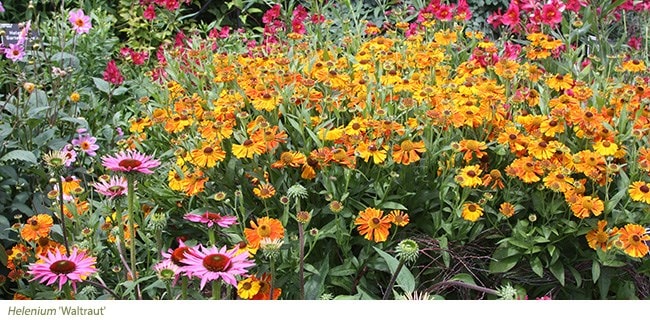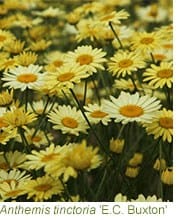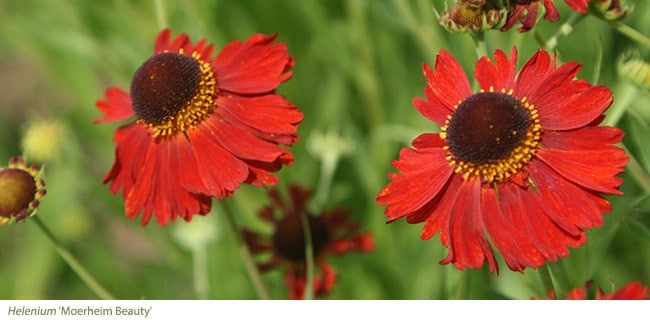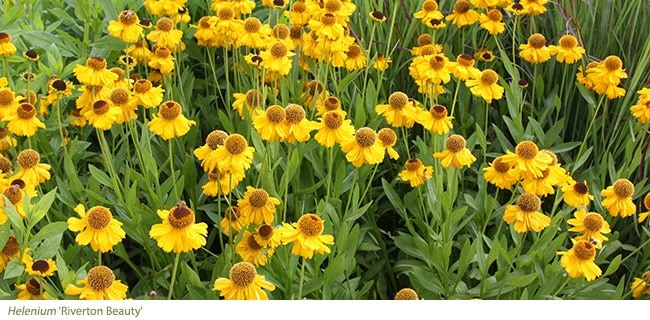Summer daisies
Late summer can be a lacklustre month in the garden, but there’s one group of plants that always shine now - and literally look as fresh as a daisy. With their bright ray petals in yellow, orange, pink, purple or white, daisies flag up their presence to pollinators who feed on their burnished middles, which are packed with tiny flowers. Hoverflies, wasps, bees and butterflies alike are sustained for weeks on end and your garden is alive with spinning plates of colour that last and last. Daisies offer great garden value.

The name daisy is a corruption of ‘day’s eye’ and the golden rule is that almost every daisy in the world loves to bask in bright sun rather than shade. Many prostrate themselves to face heavenward, as the resplendent echinacea does others, like the sunflower, chase the sun by turning their vertical flowers and moving round like the hands of a clock as the day progresses. These head turners need careful placing, otherwise you might only see their backs!
Although yellow daisies can dominate August a little too much, with careful positioning they will create a golden thread that runs through the garden tapestry. The secret is to balance your colour wheel by adding purples and blues.
 Most summer-flowering daisies tend to be golden yellow, but there are purer lemons on the cooler side. Anthemis ‘E.C. Buxton’ is a clear-yellow that’s as pure as freshly gathered lemons from Morocco. This sun lover, roughly up to 70 cm high, was found in the Welsh garden of E.C. Buxton in 1910. It bears larger flowers than most, held on wiry stems that rise above deep-green feathery foliage. Like all anthemis it prefers free-draining soil and has a short-lived tendency. Don’t let that put you off though. The solution is simple. In early summer pull a couple of pieces away and they will almost certainly have some roots attached. These ‘Irishmen’s cuttings’ will root easily and can be planted out in early September. Or replace your plants every three years.
Most summer-flowering daisies tend to be golden yellow, but there are purer lemons on the cooler side. Anthemis ‘E.C. Buxton’ is a clear-yellow that’s as pure as freshly gathered lemons from Morocco. This sun lover, roughly up to 70 cm high, was found in the Welsh garden of E.C. Buxton in 1910. It bears larger flowers than most, held on wiry stems that rise above deep-green feathery foliage. Like all anthemis it prefers free-draining soil and has a short-lived tendency. Don’t let that put you off though. The solution is simple. In early summer pull a couple of pieces away and they will almost certainly have some roots attached. These ‘Irishmen’s cuttings’ will root easily and can be planted out in early September. Or replace your plants every three years.
Equally pallid is the tall Helianthus ‘Lemon Queen’ and Her Majesty is in the top flight of daisies. This is another oldie, bred in the 1920s by Thomas Carlile of the Loddon Nursery. This Berkshire nursery used to stop the traffic on the Twyford Bypass with massed plantings on Tommy’s Corner, as it was called. Although many of his daisies have the Loddon prefix, this man-high tight clump-former was named ‘Lemon Queen’. It’s freestanding and the single lemon-yellow flowers have black-flecked middles from mid-August onwards. It’s the perfect partner for the cloud-headed, sultry reddish purple heads of Eupatorium maculatum (Atropurpureum Group) 'Riesenschirm'. This refined form with darker stems sets off the lemon daisies that angle themselves vertically and chase the sun. A south or west-facing border is ideal, not north. Or you could use the purple ironweed, Vernonia arkansana ‘Mammuth’, for its tight mophead of flowers. Like the eupatorium, it’s also a daisy without the petals so still insect friendly.

Dark stems are an added bonus and they feature strongly in
Heliopsis helianthoides var. scabra 'Summer Nights'. This flowers earlier than most
daisies, by early July, but keeps going. The wiry black stems, which reach 1.2m, branch at the top and support clusters of small single
daisies of golden yellow. Each has short, wide ray petals surrounding a large domed red middle, so this is an eye-catching plant in every respect. Grown close to
Agastache ‘Blackadder’, another black-stemmed
perennial with deep-blue bee-friendly spires, it shines.
Or if you’ve a quieter place, close to box balls for instance, the meandering, floppy dark stems and green-diamond foliage of Aster divaricatus look superb. Tiny white flowers follow in August and then heather-pink thistly heads appear, but it's principally grown for those seductive ebony stems.
Daisy middles come in many guises, but the heleniums or sneezeweeds, have brown velvet centres that fluff up as the pollinators get busy. The flowers come in shades of yellow, to orange, to mahogany-red and, if you have good soil, this is one of the best August performers of all. Heights vary from the short border edgers to the taller back of border varieties. Generally though the shorter ones flower first and the taller ones can be as late as September, often with fiery flowers.

The classic ‘Moerheim Beauty’ (1930) has grace and elegance because it’s mahogany-red flowers have a double layer of ragged-edged petals that droop down before flouncing upwards. It’s among the earliest of all, with a very dark centre, and makes the perfect partner for Agastache ‘Blue Fortune’, a mid-blue bottlebrush flower with aromatic foliage.
‘Potter’s Wheel’ is a shorter helenium, roughly 60cm in height, with a single circle of splayed out deep crimson-brown petals edged in gold. It’s very disc-like and simple, an Audrey Hepburn of the garden. 'Ruby Thuesday' is equally short with dark-red flowers that appear almost black at first. As they open the petals become quilled.

Taller heleniums include 'Rauchtopas', German for smoky topaz, the apricot petals are streaked in red on the undersides and as the petals curl upwards (in a very loose arrangement) there’s a bicolour effect of apricot and terracotta on this 1.2m high stunner. 'Riverton Beauty' is a similar height, but a sunny bright yellow with dark velvet centred middles.
|
|








